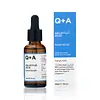What's inside
What's inside
 Key Ingredients
Key Ingredients

 Benefits
Benefits

 Concerns
Concerns

 Ingredients Side-by-side
Ingredients Side-by-side

Water
Skin ConditioningPropylene Glycol
HumectantGlycerin
HumectantBetaine
HumectantSuccinic Acid
BufferingPanthenol
Skin ConditioningSalicylic Acid
MaskingAcetyl Hexapeptide-1
Skin ConditioningAllantoin
Skin ConditioningBiosaccharide Gum-1
HumectantSodium Levulinate
Skin ConditioningGlyceryl Caprylate
EmollientSodium Gluconate
Skin ConditioningCaprylyl Glycol
EmollientXanthan Gum
EmulsifyingEthylhexylglycerin
Skin ConditioningPhenoxyethanol
PreservativeSodium Anisate
AntimicrobialSodium Hydroxide
BufferingWater
Skin ConditioningPropylene Glycol
HumectantIsostearyl Isostearate
EmollientEthyl Olivate
EmollientDimethyl Isosorbide
SolventGlycerin
HumectantTriheptanoin
Skin ConditioningCetearyl Alcohol
EmollientSqualane
EmollientHydroxypinacolone Retinoate
Skin ConditioningBisabolol
MaskingSaccharide Isomerate
HumectantJojoba Esters
EmollientHelianthus Annuus Seed Oil
EmollientHelianthus Annuus Seed Wax
Skin ConditioningTocopherol
AntioxidantO-Cymen-5-Ol
AntimicrobialXanthan Gum
EmulsifyingGlyceryl Stearate
EmollientSodium Stearoyl Glutamate
CleansingCaprylyl Glycol
EmollientPolyglycerin-3
HumectantEthylhexylglycerin
Skin ConditioningSodium Citrate
BufferingCitric Acid
BufferingWater, Propylene Glycol, Isostearyl Isostearate, Ethyl Olivate, Dimethyl Isosorbide, Glycerin, Triheptanoin, Cetearyl Alcohol, Squalane, Hydroxypinacolone Retinoate, Bisabolol, Saccharide Isomerate, Jojoba Esters, Helianthus Annuus Seed Oil, Helianthus Annuus Seed Wax, Tocopherol, O-Cymen-5-Ol, Xanthan Gum, Glyceryl Stearate, Sodium Stearoyl Glutamate, Caprylyl Glycol, Polyglycerin-3, Ethylhexylglycerin, Sodium Citrate, Citric Acid
 Reviews
Reviews

Ingredients Explained
These ingredients are found in both products.
Ingredients higher up in an ingredient list are typically present in a larger amount.
Caprylyl Glycol is a humectant and emollient, meaning it attracts and preserves moisture.
It is a common ingredient in many products, especially those designed to hydrate skin. The primary benefits are retaining moisture, skin softening, and promoting a healthy skin barrier.
Though Caprylyl Glycol is an alcohol derived from fatty acids, it is not the kind that can dry out skin.
This ingredient is also used as a preservative to extend the life of products. It has slight antimicrobial properties.
Learn more about Caprylyl GlycolEthylhexylglycerin (we can't pronounce this either) is commonly used as a preservative and skin softener. It is derived from glyceryl.
You might see Ethylhexylglycerin often paired with other preservatives such as phenoxyethanol. Ethylhexylglycerin has been found to increase the effectiveness of these other preservatives.
Glycerin is already naturally found in your skin. It helps moisturize and protect your skin.
A study from 2016 found glycerin to be more effective as a humectant than AHAs and hyaluronic acid.
As a humectant, it helps the skin stay hydrated by pulling moisture to your skin. The low molecular weight of glycerin allows it to pull moisture into the deeper layers of your skin.
Hydrated skin improves your skin barrier; Your skin barrier helps protect against irritants and bacteria.
Glycerin has also been found to have antimicrobial and antiviral properties. Due to these properties, glycerin is often used in wound and burn treatments.
In cosmetics, glycerin is usually derived from plants such as soybean or palm. However, it can also be sourced from animals, such as tallow or animal fat.
This ingredient is organic, colorless, odorless, and non-toxic.
Glycerin is the name for this ingredient in American English. British English uses Glycerol/Glycerine.
Learn more about GlycerinPropylene Glycol is an odorless, colorless liquid. As a humectant, it helps skin retain moisture. It also aids in delivering active ingredients.
Another role of this ingredient is preventing a product from melting or freezing. Propylene glycol also adds antimicrobrial properties to a product, elongating product lifespan.
This ingredient is considered an organic alcohol and commonly added into both cosmetics and foods.
Those with sensitive skin or conditions may develop a rash when using this ingredient.
Learn more about Propylene GlycolWater. It's the most common cosmetic ingredient of all. You'll usually see it at the top of ingredient lists, meaning that it makes up the largest part of the product.
So why is it so popular? Water most often acts as a solvent - this means that it helps dissolve other ingredients into the formulation.
You'll also recognize water as that liquid we all need to stay alive. If you see this, drink a glass of water. Stay hydrated!
Learn more about WaterXanthan gum is used as a stabilizer and thickener within cosmetic products. It helps give products a sticky, thick feeling - preventing them from being too runny.
On the technical side of things, xanthan gum is a polysaccharide - a combination consisting of multiple sugar molecules bonded together.
Xanthan gum is a pretty common and great ingredient. It is a natural, non-toxic, non-irritating ingredient that is also commonly used in food products.
Learn more about Xanthan Gum